with additional extension.
This horn was originally owned by eminent horn historian, Reginald Morley-Pegge and later sold to his good friend, Harold Meek of the Boston Symphony. In 2008 it was purchased as a gift to Louis Denaro and quickly became one of his favorite playing horns. Because of its provenance and historical significance, however, Mr. Denaro has graciously consented to transfer it into this collection.
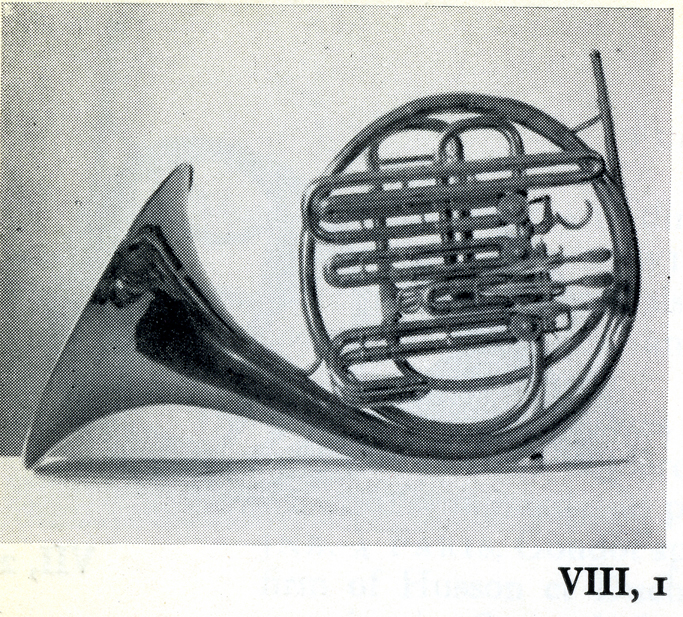
The illustration above appears as photo 1 in plate VIII of Reginald Morley-Pegge's classic landmark book, The French Horn (1973) with the following description:Single B-flat horn with a long variable slide to the thumb valve. This valve can be tuned to lower the pitch to any extent from a semitone to a fourth. String action valves. Marked: C. F. SCHMIDT. Grossherzogl Säch: Hof-Instrumentenmacher BERLIN S.W.19. Früher WEIMAR.Without referencing the photo, Mr. Morley-Pegge (p. 5) describes the use of such a horn:Some players, generally to be found among those who occupy the first or third chair, prefer a single B-flat horn with an extra valve, controlled by the thumb, which may either carry a semitone slide or a slide long enough to give the instrument a downward range equal to that of the F horn. The single horn has the advantage of less weight, but the fingering and intonation are apt to be rather tricky, while, unless in the hands of a sensitive player, its tone can be very harsh.It appears that at the time the horn was not kept in the best of condition since the three main valve levers appear to be sprung by elastic bands! According to the Bate Collection at Oxford University which contains many of Mr. Morley-Pegge's horns, this was in fact his personal instrument:Morley-Pegge formed his technique on the classical French instrument to which he long remained faithful. The increasing difficulty of modern horn parts, however, led him to adopt a B-flat instrument by Schmidt of Berlin, with a transposing valve adjustable between a semitone and a perfect fourth. This instrument was, after Morley-Pegge's death, bought by one of his friends by correspondence (they never met), Harold Meek, hornist with the Boston Symphony Orchestra and first editor of The Horn Call, journal of the International Horn Society.Indeed, Mr. Meek also preferred to play a single B-flat horn by Carl Geyer fitted with two additional valves, one as a stopping valve and the other as an F extension. This was no doubt a topic of his correspondence with Mr. Morley-Pegge.
In 1970 Mr. Morley-Pegge received an inquiry from the Musikinstrumentmuseum of the Staatliches Institute für Musikforschung in Berlin concerning this horn and another instrument in his collection. In a draft reply to that inquiry, also in the Bate collection, Mr. Morley-Pegge had this to say concerning this horn:In answer to your letter dated 18th August, my Schmidt horn is the one illustrated in Plate VIII fig. 1 of my book...This answers obvious qustions regarding some of the non-Schmidt-like details on this horn. In particular the peculiar shape of the third valve slide, uncharacteristic telescoped tubing joints, and dissimilar ferrules. Regarding the fourth valve, notice in the above photo that the thumb rotor is slightly larger than the others and has a different cap (flatter nipple). This can also be seen in the photos that follow. It is clear that this valve assembly is from another horn and that the instrument was originally a single three valved horn. It is shown in the photos below in its present condition. (Note that in the accompanying text there are links to additional photos to further illustrate the point.)
I understand that originally it was a single horn in F, but was later modified into a single B flat horn with 3 valves. The fourth valve as added by a friend from whom I bought it -a dentist by profession but an amateur horn player. It is an excellent horn with a very fine tone and no bad notes, and I used it regularly in my professional work during the last ten years or so when I still played. I am now over 80 and can no longer produce a sound on the horn! The bell is plain i.e. no guirlande. I should say this horn was made in the 1880's. In the description there are two regrettable misprints: Grossherzgol instead of Grossherzogl. and ommission of the the dieresis over the a in Sachs.
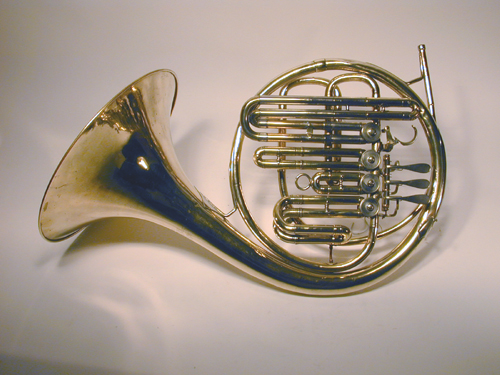
Click for a larger view
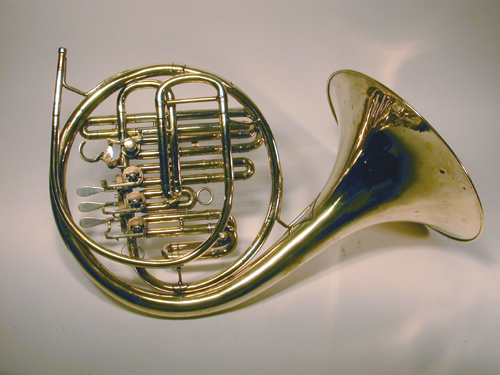
Click for a larger view
From the player's side of the horn can be seen a brace between the first branch and the main tuning slide (at about 2 o'clock in the above photo). This brace is hidden by the thumb valve slide when viewed from the front of the horn and is in fact not visible in the previous photo nor in the Morley-Pegge plate. It is not where one would expect such a brace to be located and in fact a tell-tale scar lower down on the first branch is evidence that it has been moved from its original factory position for no good or apparent reason. If it were in its original location at the time of the Morley-Pegge photo it would have been clearly visible about even with the second valve slide. There is now a brace at about the six o'clock position which was not present at the time of the Morley-Pegge photo. It is not of the character of those used by C.F. Schmidt and was obviously added to correct the instability introduced by moving the brace described previously.
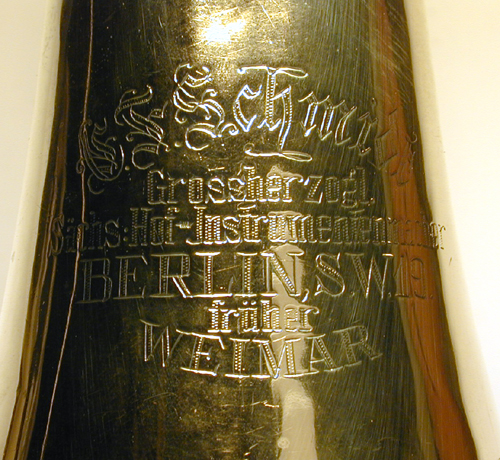
Click for a larger view
The label is exactly as quoted by Mr. Morley Pegge. Its style, wording, and reference to "Berlin previously Weimar" probably establishes the horn's date of manufacture to before World War I. Following the war Schmidt returned to Weimar and the citation became "Weimar previously Berlin" until eventually dropping references to Berlin altogether.

Click for a larger view
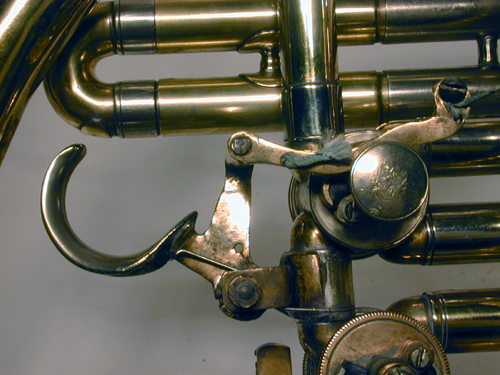
Click for a larger view
The head on the retaining screw on the thumb rotor is about the size of a dime while the others are of the typical slotted variety used by Schmidt. The threads are also different from the other three screws so that it cannot be interchanged with them. The legs on the thumb valve are nickel-silver while the other three are brass. The very large thumb valve hook is apparently actually the thumb rest removed from the original three-valved single horn as evidenced by the solder scars found on the surface of the bell tail exactly where such a thumb rest would have been located. The leverage for the thumb rotor is set up such that the bar that carries the string actually rides in contact on top of the rotor spindle. Also the oddly shaped thumb lever (to which the hook is soldered) is crudely cut from a piece of sheet brass and not consistent with the quality of workmanship expected of a maker of the stature of C.F. Schmidt.
There is evidence that the leadpipe has been replaced. A solder scar is certain evidence that the leadpipe bracket has been repositioned to accomodate a different pipe curvature. One observer has noted that the color of the pipe is slightly different from the rest of the horn indicating that it is probably of a slightly different brass alloy. In addition the nickel-silver cap at the mouthpiece receiver is not at all similar to those found on other C.F. Schmidt horns.
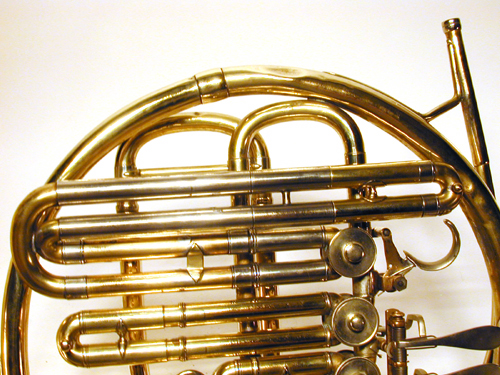
Click for a larger view
The thumb valve slide tubing components (shown as separate pieces below) are of a different diameter than the three main valves. The tubing for the thumb valve has an inside diameter of 11.9 mm while the other slides are 11.8 mm which is the bore size found in the cylindrical section of most other Schmidts. Curiously, the outside diameter is actually somewhat smaller on the thumb slides such that the other slides won't fit into its legs and conversely the thumb slide is too loose in the other valve legs. (By comparison the second valve slide from a Schmidt double horn fits the second valve just fine.) The thumb valve extension comprises several telescoping sections of various metals which gives the tuning versatility that Mr. Morley-Pegge describes. This valve was probably originally the third valve of the donor horn judging from the dog-leg turn (leftmost component shown below). The nickel-silver sleeves on this part are apparently taken from two different slides since they are both marked (one on the front the other on the back) with the witness marks commonly found only on one slide leg for proper orientation. It is clearly evident that the thumb valve assembly is an amalgamation of miscellaneous parts from another horn having a slightly larger bore.
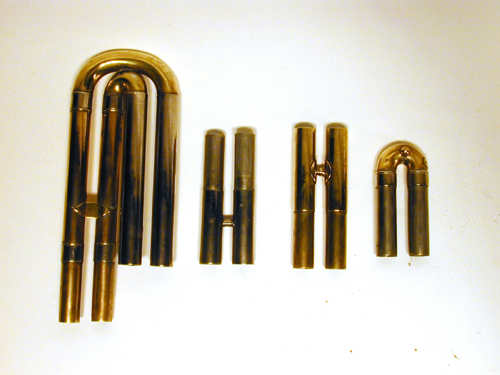
Click for a larger view
The great British horn soloist, Dennis Brain, had exactly this type of modification made to his Gebr. Alexander single B-flat horn on which he played and recorded late in his tragically short career. In general, despite the sometimes less than professional extensive repair workmanship, this horn plays very well.
Special thanks to Louis Denaro for parting with this valuable and historically interesting horn, and making it available to the collection.
Thanks, too, to Dr. Andrew Lamb, curator of the Bate Collection of Musical Instruments at Oxford University, for making available the hand-written draft of Mr. Morley-Pegge's letter quoted above.